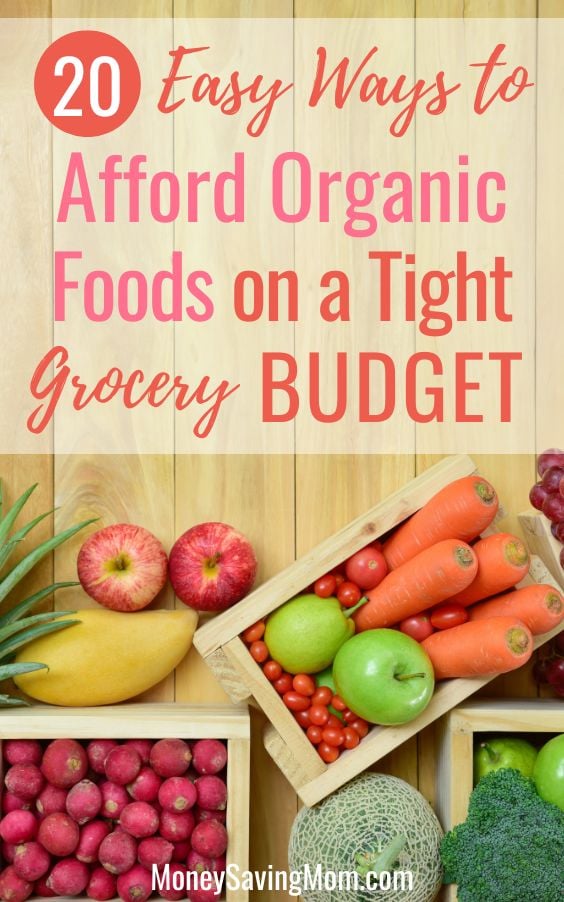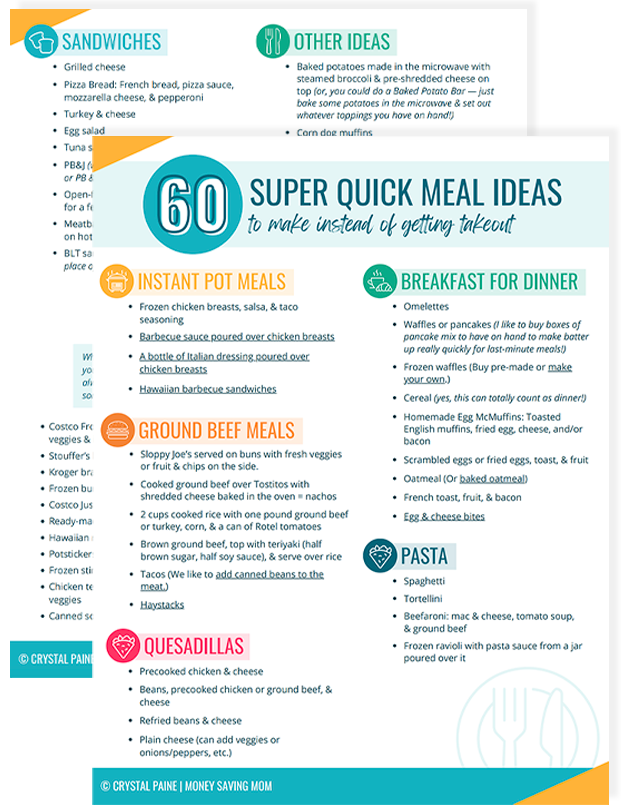Is it possible to afford organic foods on a tight budget? Yes! Keep reading for 20 ways to save money on organic food — even if you have a tight budget!
Eating Healthy Doesn’t Have to Be Expensive!
Many people have a misguided idea that eating healthfully requires a huge budget… but that’s just not the case.
Ok, well, if you live in Alaska or some remote part of the country, this might be true; but in most areas, you can feed your family natural, unprocessed, even organic foods without spending a fortune — especially if you’re willing to get creative and think outside the box!
20 Ways to Afford Organic Foods on a Budget
Here are several ways to afford organic food on a tight budget:
1. Plan your menu based on what’s in season and on sale.
If you want to feed your family on a budget, the first step is to have a plan for what you’ll eat. Regardless of your special diet or food preferences, meal planning will always save you money.
You’ll significantly reduce your grocery bill if you intentionally plan your menu around what’s on sale at the natural foods store, what’s in season at the Farmer’s Market, what organic foods are on sale at Aldi or your local grocery store, and/or what your garden is producing.
As an added bonus, you’ll reap the benefits of a balanced diet as you’ll constantly be rotating your produce based on what’s in season!
2. Calculate the cost of your meals.
When you’re planning your menu, think about how much each recipe will cost. Cutting costs on a meal in general will create more wiggle room in your budget to prioritize organic items.
It doesn’t have to be a scientific, to-the-penny figure, but just having a good idea that there is a $10 difference between the price of making one meal as opposed to another meal can help with keeping your grocery budget down.
3. Practice the “buy ahead” principle.
If your budget allows, stock up whenever you find an incredible sale on organic items. This could be organic tomatoes at the Farmer’s Market, markdown deals on organic produce/bread/meat at Kroger, reduced-price organic frozen veggies at the health food store, a super weekend sale at Sprouts, or if Aldi is offering a great deal on organic products.
Buying items you routinely use when they are at their lowest price is a surefire way to save more.
4. Buy in bulk.
It is usually much more cost-effective to purchase meat and staple ingredients in bulk.
Call around to local farmers and see what they would charge you for purchasing half a cow. In many cases, this meat is at least $1 cheaper per pound to purchase in bulk. And the meat is a much higher quality.
Buying organic grains, beans, and other basic ingredients with long storage lives in large quantities will almost always save you at least 20%, if not more.
5. Focus on the worst offenders.
Environmental Working Group’s Dirty Dozen and Clean Fifteen lists are a great place to start when trying to prioritize organic purchases.
These lists will help you steer clear of the stuff with the most pesticides, and save money buying conventional when it comes to the cleanest fruits and veggies.
6. Plant a garden.
Produce is typically only pennies per item from your own backyard, it’s tremendously fresh and you know exactly what you did or didn’t spray on it. Plus, if you can or freeze your extras, you’ll be able to enjoy “fresh-from-the-garden” produce for much of the year.
Have a brown thumb? Find a friend who loves gardening and trade services (babysitting, bread-baking, car maintenance) in exchange for their garden excess.
If organic product is something you’d like to prioritize, you won’t find it at a better price than if you grow it on your own! It’s a fantastic option on a budget.
7. Consider joining a CSA or Co-Op.
If gardening isn’t for you, you might look for a co-op or CSA in your area. They do usually have a fee to join the group, but it still might be a money-saving option on organic produce for your family.
And if you can’t find an affordable co-op in your area, you could consider starting your own co-op.
8. Serve meat as a condiment.
Serving meat in soup, on a salad, or as a pizza topping is going to be a lot less expensive than serving it as the main dish, especially if you’re buying high-quality organic and grass-fed meat.
9. Make homemade snacks.
Pre-packaged snacks are significantly more expensive than homemade snacks.
As a bonus, homemade snacks are often more nutritious as you can control exactly what ingredients you use.
10. Skip organic “junk food”.
It’s probably a better use of your cash to spend it on organic produce versus organic candy, fruit snacks, or other sweet treats that you don’t technically need to buy anyway!
11. Swap out expensive ingredients.
You probably don’t really need Gruyere cheese… Swiss will do just fine!
And you likely don’t need that fancy (a.k.a. expensive) chocolate when store-brand chocolate chips will work.
If you’re using a recipe that requires a specialty ingredient you don’t already have in the house, do a quick Google search to see what you could substitute instead.
12. Eat your leftovers.
Repurposing leftover meals into lunches is a great way to save money on groceries and time in the kitchen. Not having to buy a lot of extras for additional meals can help save money — especially if you’re prioritizing organic items.
13. Use coupons.
Although they are harder to come by, there are organic-based coupons available online. Also, take time to email your favorite companies, because they might just send you coupons by mail!
14. Use coupons on non-food items.
If you can’t find coupons for the organic food items you purchase, you can still use coupons to save on toilet paper, toothbrushes, and other non-food items — lowering your overall grocery costs.
15. Avoid specialty stores.
Although they have great selections of unique items, you typically pay a lot more across the board.
16. Opt for frozen produce.
Fruit and veggie smoothies are a great way to get your greens all year round. However, buying these ingredients organic 12 months a year isn’t always realistic.
Before abandoning organic produce all together, take a look in the frozen section and you may be surprised to find organic, frozen alternatives can mean fantastic savings.
And most frozen foods are frozen immediately after harvesting so they are packed with vitamins and nutrients that can sometimes be lost in fruits that sit on store shelves for a week.
17. Find a local Amish community.
They often sell lots of produce, breads, and cheese at reasonable prices — and they are almost always organic and homemade (and delicious!).
18. Buy the store brand.
Most stores have their own brand of organic foods these days — saving you quite a bit on your overall bill without much difference in taste or quality.
19. Don’t forget about Farmer’s Markets.
Your local farmer’s market is a valuable resource! There are SO many local farmers who grow delicious, organic food for much lower prices than you’ll find at any store.
20. Shop at Costco, Aldi, or Trader Joe’s
You can often find great deals on organic items at Costco, Aldi, or Trader Joe’s for great prices! You might also try Thrive Market for specific organic items you’re looking for.



